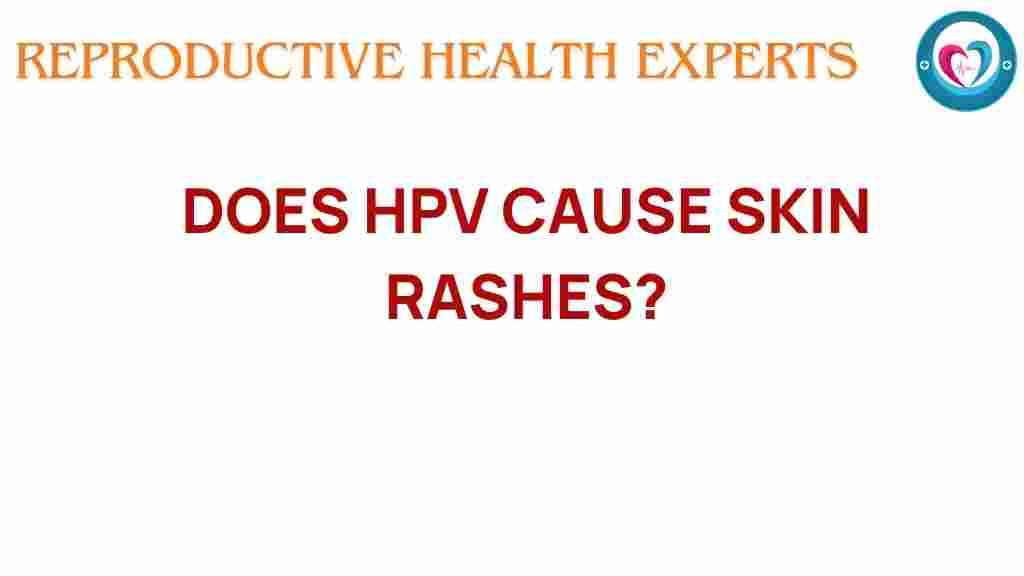Unraveling the Mystery: Does HPV Really Cause Skin Rashes?
The human papillomavirus (HPV) is a well-known viral infection that primarily affects the skin and mucous membranes. While most people associate HPV with warts or cervical cancer, there is a growing curiosity about whether HPV can also lead to skin rashes. In this article, we will explore the connection between HPV and skin rashes, shedding light on symptoms, health myths, and various skin conditions linked to this viral infection.
Understanding HPV and Its Effects on the Skin
HPV is a group of more than 200 related viruses, some of which are known to cause skin warts, while others are linked to more serious health issues. The virus is typically transmitted through direct skin-to-skin contact, making it one of the most common sexually transmitted infections (STIs) worldwide.
While HPV can cause visible manifestations like warts, many people wonder if it can also result in skin rashes. To better understand this, it is essential to recognize that not all skin conditions are directly caused by HPV.
Common Symptoms of HPV
HPV infection can present various symptoms, depending on the type of virus and the area affected. Here are some common symptoms associated with HPV:
- Warts: These are the most visible symptoms of HPV, appearing on various parts of the body.
- Genital Warts: A specific type of wart that appears in the genital area, often causing discomfort.
- Changes in Skin Color: Some HPV types may cause discoloration of the skin, though this is not a rash.
- Cervical Changes: In women, HPV can lead to changes in cervical cells, which may result in abnormal Pap test results.
HPV and Skin Rashes: The Connection
When it comes to skin rashes, it’s crucial to differentiate between conditions caused by HPV and those triggered by other factors. Here are some insights into this relationship:
- HPV and Warts: While warts can be mistaken for rashes, they are distinct skin growths caused by the virus.
- Secondary Infections: Individuals with HPV may develop secondary infections due to compromised skin integrity, leading to rashes.
- Misdiagnosis: Some people may misinterpret skin conditions unrelated to HPV as being caused by the virus.
Health Myths Surrounding HPV and Skin Conditions
Many myths circulate regarding HPV and its effects on the skin. Here are some common misconceptions:
- Myth 1: HPV always causes visible symptoms.
Truth: Many HPV infections are asymptomatic, meaning individuals may carry the virus without any visible signs. - Myth 2: HPV causes all skin rashes.
Truth: Skin rashes can result from various causes, including allergies, other infections, and skin conditions. - Myth 3: HPV is only a concern for sexually active individuals.
Truth: While sexually active individuals are at higher risk, HPV can also be transmitted through non-sexual contact.
Common Skin Conditions That May Be Confused with HPV Symptoms
It is essential to recognize other skin conditions that may resemble symptoms of HPV. Here are a few:
- Psoriasis: A chronic autoimmune condition that causes red, scaly patches on the skin.
- Eczema: This skin condition leads to dry, itchy, and inflamed skin, often mistaken for HPV-related issues.
- Contact Dermatitis: An allergic reaction that causes rashes due to contact with irritants or allergens.
- Fungal Infections: Conditions like ringworm can lead to rashes that may be confused with HPV symptoms.
Step-by-Step Process: Diagnosing Skin Rashes Related to HPV
If you experience unusual skin symptoms and suspect they may be linked to HPV, follow this step-by-step process for diagnosis:
- Observe the Symptoms: Take note of the appearance, location, and duration of your skin symptoms.
- Consult a Healthcare Provider: Schedule an appointment with a dermatologist or healthcare provider for an evaluation.
- Undergo Tests: Your provider may recommend tests, such as a biopsy or HPV testing, to determine the cause of your symptoms.
- Receive a Diagnosis: Based on the results, your provider will diagnose whether the symptoms are related to HPV or another condition.
- Follow Treatment Recommendations: Adhere to the treatment plan provided by your healthcare professional.
Troubleshooting Tips for Managing Skin Rashes
If you have identified that your skin rash is not related to HPV but still causes discomfort, here are some troubleshooting tips:
- Keep the Area Clean: Gently wash the affected area with mild soap and water to prevent irritation.
- Avoid Irritants: Steer clear of harsh soaps, fragrances, and lotions that may exacerbate your condition.
- Moisturize: Use a gentle, fragrance-free moisturizer to keep the skin hydrated.
- Cool Compress: Apply a cool compress to soothe itching or inflammation.
- Seek Professional Help: If symptoms persist or worsen, consult a healthcare provider for further evaluation.
Conclusion
In summary, while HPV is primarily known for causing warts and being linked to certain cancers, the connection between HPV and skin rashes is not straightforward. Many skin rashes are due to other factors and may be confused with HPV-related symptoms. It is essential to understand the differences and myths surrounding this viral infection and seek professional help for proper diagnosis and treatment.
If you have further questions about HPV and its effects on skin conditions, consider visiting health resources or consulting a healthcare provider for personalized advice. Remember, knowledge is key to dispelling health myths and ensuring proper skin health.
Always prioritize your health and seek medical advice when in doubt about your symptoms. Understanding your body and its responses to infections like HPV can empower you to take control of your health.
This article is in the category Conditions and created by ReproductiveHealthExperts Team

1 thought on “Unraveling the Mystery: Does HPV Really Cause Skin Rashes?”